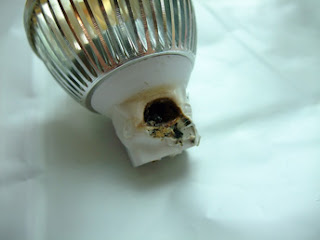 |
| With enough energy to burn a hole through the base of the LED, no wonder the LED popped out of the lighting socket. (Photo: CathC) |
Has anyone really have an LED bulb they've been using for 10+ years? I wonder how long LEDs really last in a typical home environment...
 |
| What the LED bulb look like after it burnt out. (Photo: CathC) |
Although LED bulbs are gaining popularity here as alternatives to incandescent bulbs, not too many stores in our area had them in stock. Most stores that sold light bulbs just had
Then I got to thinking how the number of light bulbs in our home compares to those in other countries. Quickly scanning our flat, I counted about 20 light bulbs. This is low compared to the average home in the United States, Canada or Britain. Colin Humphreys, a prof at the University of Cambridge and an expert in the field of solid state lighting, reports there are 45 light bulbs in the average house in the United States, 30 in Canada; and 25 in the United Kingdom.
But considering our flat is less half the size of the average house in these other countries, we have a significant number of light bulbs. It's no wonder that the majority of light bulbs that are used (installed by the owner) are either CFLs or LEDs.
In the end we still chose to continue using LED bulbs despite our experience with it shorting out. Generally speaking the advantages of LED bulbs (energy usage, lifetime) still outweigh the other alternatives, which is important considering the
compact fluorescent lamps (CFLs) or incandescent bulbs. Only one of the larger supermarket chains had a single brand of LEDs in stock.
Then I got to thinking how the number of light bulbs in our home compares to those in other countries. Quickly scanning our flat, I counted about 20 light bulbs. This is low compared to the average home in the United States, Canada or Britain. Colin Humphreys, a prof at the University of Cambridge and an expert in the field of solid state lighting, reports there are 45 light bulbs in the average house in the United States, 30 in Canada; and 25 in the United Kingdom.
But considering our flat is less half the size of the average house in these other countries, we have a significant number of light bulbs. It's no wonder that the majority of light bulbs that are used (installed by the owner) are either CFLs or LEDs.
In the end we still chose to continue using LED bulbs despite our experience with it shorting out. Generally speaking the advantages of LED bulbs (energy usage, lifetime) still outweigh the other alternatives, which is important considering the
number of lights we have in our home!
--
Humphreys,
No comments:
Post a Comment